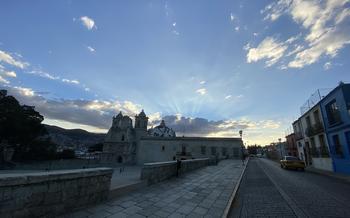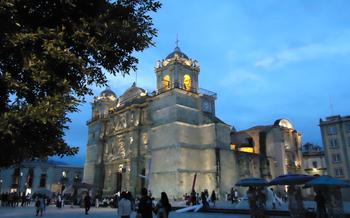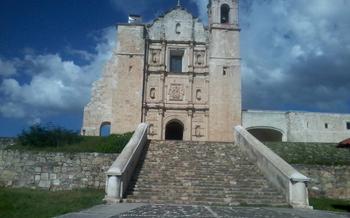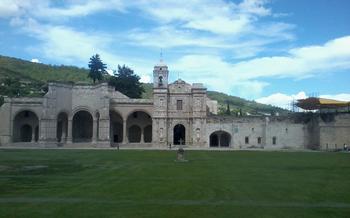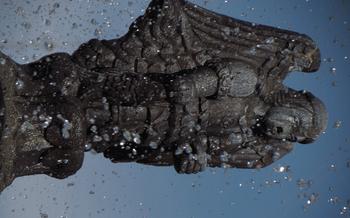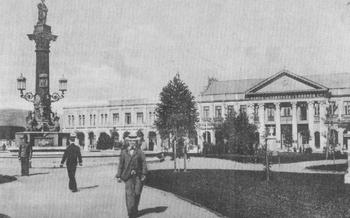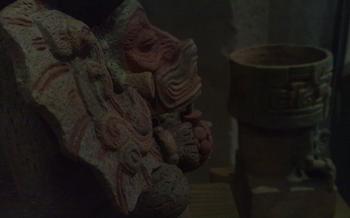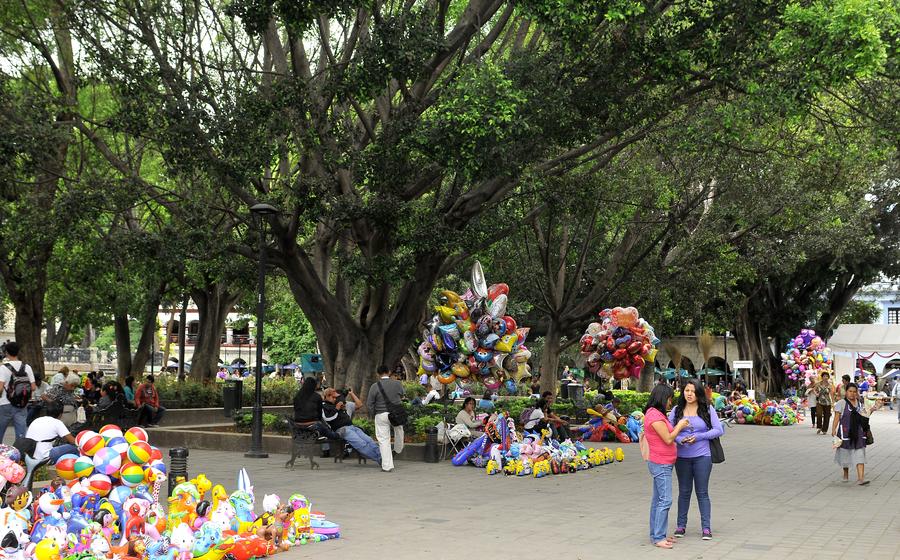
Zócalo de Oaxaca
- Culture
- Architectural Wonders: A Symphony of Styles
- Lively Atmosphere: A Fiesta for the Senses
- Local Traditions: Immerse in Oaxaca's Essence
- Palacio de Gobierno: Murals that Speak
- Templo de Santo Domingo de Guzmán: Baroque Splendor
- Museo de las Culturas de Oaxaca: A Cultural Tapestry
- Street Vendors: A Culinary and Cultural Delight
- Traditional Dance Performances: Rhythms of Oaxaca
- Festive Events and Celebrations: A Year-Round Fiesta
- Nightlife: A Lively Scene
- Traditional Oaxacan Cuisine: A Culinary Adventure
- Mezcal Tasting: A Journey of Flavors
Culture
The Zócalo de Oaxaca is steeped in history and culture, serving as the heart of this vibrant city. Once the center of ancient Zapotec and Mixtec civilizations, the square witnessed the arrival of the Spanish in the 16th century, leading to a fusion of cultures that shaped Oaxaca's unique identity. During Mexico's independence movement, the Zócalo played a pivotal role as a gathering place for protests and celebrations, leaving an indelible mark on the nation's history. Today, the square brims with life, hosting traditional dance performances, festive events, and lively street vendors, offering a vibrant glimpse into Oaxaca's rich cultural heritage. The best time to visit the Zócalo is during the Guelaguetza festival, held annually in July, where indigenous communities from across the state gather to showcase their traditional dances, music, and customs, creating an unforgettable spectacle of color, rhythm, and cultural pride.
Architectural Wonders: A Symphony of Styles
The Zócalo de Oaxaca is a showcase of architectural marvels that blend seamlessly with the city's rich history and culture. The majestic Catedral de Nuestra Señora de la Asunción stands as a testament to the grandeur of Baroque architecture, with its intricate facade, soaring spires, and opulent interior. The Palacio de Gobierno, adorned with Diego Rivera's iconic murals, narrates the story of Oaxaca's past and present through vibrant colors and powerful imagery. The Templo de Santo Domingo de Guzmán, with its elaborate carvings and gilded altars, is a testament to the artistry and devotion of the Dominican order. And the Museo de las Culturas de Oaxaca, housed within the former convent of Santo Domingo, takes visitors on a journey through the diverse cultural heritage of the region. Together, these architectural wonders create a symphony of styles that reflects Oaxaca's unique identity.
Lively Atmosphere: A Fiesta for the Senses
Oaxaca's Zócalo pulsates with life, offering a sensory feast for visitors. Every corner of the square comes alive with vibrant street vendors showcasing local delicacies and handmade crafts that reflect the region's rich cultural heritage. The air fills with the tantalizing aromas of freshly grilled tlayudas, sizzling tamales, and toasted chapulines, tempting passersby with their unique flavors.
Traditional dance performances add to the lively atmosphere of the Zócalo, showcasing the diverse cultural tapestry of Oaxaca. Local dance troupes in colorful costumes perform traditional dances like the Guelaguetza and the Jarabe Zapoteco, captivating audiences with their rhythmic movements and infectious energy. These performances provide a glimpse into Oaxaca's deep-rooted cultural traditions and offer visitors a chance to witness the vibrant spirit of the region.
Throughout the year, the Zócalo hosts a variety of festive events and celebrations that draw locals and tourists alike. The Guelaguetza festival, held annually in July, is a grand indigenous festival that showcases traditional dances, music, and cultural exhibitions from across Oaxaca. The city transforms into a kaleidoscope of colors as costumed dancers, musicians, and artisans gather to celebrate the region's rich heritage.
As the sun sets, the Zócalo transforms into a lively nightlife hub, with a plethora of bars, restaurants, and music venues catering to every taste. Rooftop bars offer stunning views of the illuminated Zócalo, while live music venues host local and international artists, creating a vibrant atmosphere that invites visitors to unwind and socialize. With its diverse offerings, the Zócalo promises an unforgettable experience, immersing visitors in the lively spirit and rich cultural traditions of Oaxaca.
Local Traditions: Immerse in Oaxaca's Essence
Oaxaca's traditions are a vibrant tapestry woven with indigenous customs, colonial influences, and modern expressions. One of the most renowned events is the Guelaguetza, a colorful indigenous festival held annually in July. This eight-day extravaganza showcases traditional dances, music, and costumes from Oaxaca's eight regions. Dancers clad in elaborate attire perform mesmerizing routines, accompanied by rhythmic music and the cheers of the crowd. The Guelaguetza is a testament to Oaxaca's rich cultural heritage and a must-see experience for visitors seeking a glimpse into the region's soul.
Another significant tradition is the Día de los Muertos, or Day of the Dead, celebrated annually from October 31st to November 2nd. During this time, families honor their deceased loved ones by creating elaborate altars decorated with marigolds, candles, and offerings of food and drink. The altars serve as a bridge between the living and the dead, allowing families to connect with their departed relatives. The Día de los Muertos is a unique and poignant celebration that showcases Oaxaca's unique blend of indigenous and Catholic beliefs.
Oaxaca's culinary scene is a reflection of its rich traditions, offering a diverse range of flavors and textures. Traditional dishes like tlayudas, large, crispy tortillas topped with beans, meat, and cheese, and tamales, steamed cornmeal dumplings filled with various fillings, are a must-try for food enthusiasts. For a truly adventurous experience, sample chapulines, fried grasshoppers, a local delicacy that is both nutritious and delicious. Oaxaca's culinary traditions are a testament to the region's cultural diversity and a delight for visitors seeking authentic gastronomic experiences.
Finally, no exploration of Oaxaca's traditions is complete without experiencing mezcal, the region's artisanal spirit. Mezcal is made from roasted agave hearts and has a smoky, complex flavor that sets it apart from tequila. Visitors can embark on mezcal tasting experiences at local distilleries and mezcalerías, where they can learn about the production process and sample different types of mezcal. From traditional Guelaguetza dances to the unique flavors of mezcal, Oaxaca's traditions offer a captivating glimpse into the region's rich cultural heritage.
Palacio de Gobierno: Murals that Speak
Palacio de Gobierno, renowned Mexican artist Diego Rivera. These murals, painted between 1927 and 1931, depict the history, culture, and social struggles of Oaxaca, offering a profound insight into the state's rich heritage.
Rivera's murals adorn the palace's interior courtyard, covering over 200 square meters of wall space. They depict scenes from pre-Hispanic times to the Mexican Revolution, capturing the essence of Oaxaca's unique identity. The murals are a powerful testament to Rivera's artistic genius and his commitment to social justice.
One of the most iconic murals, titled "Glorification of Quetzalcoatl," portrays the mythical feathered serpent god revered by ancient Mesoamerican cultures. The mural showcases Rivera's mastery of color and composition, creating a visually stunning and thought-provoking masterpiece.
Another notable mural, "The History of Oaxaca," depicts key moments from the state's history, including the Spanish conquest, the Mexican Revolution, and the struggle for social justice. Rivera's murals not only beautify the Palacio de Gobierno but also serve as a powerful reminder of Oaxaca's rich cultural legacy and its ongoing pursuit of social transformation.
Guided tours of the Palacio de Gobierno are available, providing visitors with a deeper understanding of the historical and artistic significance of Rivera's murals. These tours offer insights into the artist's creative process, the techniques he employed, and the social and political context that influenced his work.
Templo de Santo Domingo de Guzmán: Baroque Splendor
Among the architectural marvels surrounding the Zócalo, the Templo de Santo Domingo de Guzmán stands out with its Baroque splendor. Its elaborate facade, adorned with intricate carvings and sculptures, hints at the opulence that awaits inside. Once you step through its grand entrance, you'll be captivated by the stunning interior, adorned with gilded altars, opulent decorations, and a breathtaking dome.
This former Dominican monastery, now a church and museum, is a testament to the artistic and religious heritage of Oaxaca. The intricate details in every corner, from the carved choir stalls to the ornate side altars, showcase the exceptional craftsmanship of the era.
Don't miss the Museo de las Culturas de Oaxaca, housed within the temple complex. This renowned museum takes you on a journey through the diverse cultures that have shaped Oaxaca's rich history. With an extensive collection of pre-Hispanic artifacts, interactive exhibits, and educational programs, it's a must-visit for anyone interested in exploring Oaxaca's cultural tapestry.
Museo de las Culturas de Oaxaca: A Cultural Tapestry
Nestled within the historic Templo de Santo Domingo de Guzmán, the Museo de las embark on a journey through time, where pre-Hispanic pottery, intricate textiles, and ceremonial objects narrate the stories of ancient civilizations.
Discover the Zapotec and Mixtec cultures, whose legacies live on through the exquisite craftsmanship and artistic expressions showcased in the museum's exhibits. Interactive displays and educational programs bring the past to life, offering visitors a deeper understanding of Oaxaca's rich cultural heritage.
From ancient Zapotec funerary urns adorned with intricate glyphs to elaborately woven Mixtec textiles depicting mythical creatures, the museum showcases the artistry and craftsmanship that have defined Oaxaca's cultural identity. Immerse yourself in the vibrant traditions and customs of Oaxaca's indigenous communities, and gain a profound appreciation for the cultural tapestry that makes this region so unique.
Street Vendors: A Culinary and Cultural Delight
Amidst the vibrant atmosphere of the Zócalo, street vendors play a vital role in showcasing Oaxaca's culinary and artistic traditions. From tantalizing local delicacies to handmade crafts, these vendors offer a unique glimpse into the heart of Oaxacan culture.
Indulge in the flavors of Oaxaca by sampling the array of local delicacies on offer. Tlayudas, large, crispy tortillas topped with beans, cheese, and meat, are a must-try. Tamales, steamed corn dough parcels filled with savory fillings, are another popular treat. For a unique culinary experience, try chapulines, toasted grasshoppers seasoned with chili and lime.
In addition to food, street vendors also showcase their artistic talents through handmade crafts. Browse through intricate textiles, colorful pottery, and unique jewelry, all crafted with love and care by local artisans. Bargaining and haggling are part of the experience, so don't be afraid to engage with the vendors and negotiate for the best prices.
Shopping at the Zócalo's street vendors is not just about acquiring souvenirs; it's about supporting the local community and immersing yourself in Oaxaca's vibrant cultural heritage. Take the time to interact with the vendors, learn about their stories, and appreciate the artistry and flavors that make Oaxaca so special.
Traditional Dance Performances: Rhythms of Oaxaca
Oaxaca is renowned for its vibrant and diverse dance traditions, which are proudly showcased in traditional dance performances throughout the city. Local dance troupes take center stage, mesmerizing audiences with their graceful movements, colorful costumes, and rhythmic music.
The traditional dances of Oaxaca, such as the Guelaguetza and the Jarabe Zapoteco, tell stories of the region's history, culture, and traditions. Performers don elaborate costumes adorned with intricate embroidery, feathers, and mirrors, adding to the visual spectacle.
These dance performances are not merely entertainment; they are a vital part of Oaxaca's cultural heritage. They provide a platform for indigenous communities to share their traditions and stories with the world, fostering a sense of pride and identity.
For visitors, attending a traditional dance performance is an immersive experience that allows them to witness the beauty and diversity of Oaxaca's cultural tapestry. Whether it's the graceful movements of the Guelaguetza or the lively rhythms of the Jarabe Zapoteco, these performances offer a glimpse into the soul of Oaxaca.
So, when in Oaxaca, make sure to catch a traditional dance performance. It's an opportunity to witness the vibrant spirit of this region and create memories that will last a lifetime.
Festive Events and Celebrations: A Year-Round Fiesta
Oaxaca is renowned for its vibrant and colorful festivals, which offer a unique glimpse into the region's rich cultural heritage. The most famous of these is the Guelaguetza, a grand indigenous festival held annually in July. During this festival, representatives from different regions of Oaxaca gather in the Zócalo to showcase their traditional dances, music, and costumes. The atmosphere is electric, with the Zócalo transformed into a sea of color and movement.
Other notable festivals include the Día de los Muertos (Day of the Dead) celebrations, which take place every November. During this time, families create elaborate altars to honor their deceased loved ones, and the streets are adorned with colorful decorations.
Oaxaca also celebrates Christmas and New Year's Eve in a unique and festive way. During Christmas, the Zócalo is decorated with twinkling lights and nativity scenes, while on New Year's Eve, locals gather in the square to enjoy live music, fireworks, and traditional food.
With its year-round calendar of events, Oaxaca offers visitors a chance to immerse themselves in the region's vibrant culture and traditions.
Nightlife: A Lively Scene
As the sun sets over the Zócalo, a vibrant transformation takes place, turning the square into a lively hub of nightlife. The streets come alive with the sounds of music, laughter, and clinking glasses as locals and tourists alike spill out of bars, restaurants, and music venues.
Oaxaca's nightlife scene offers something for everyone, from intimate cocktail bars to lively dance clubs. Rooftop bars provide stunning views of the illuminated Zócalo, while traditional mezcalerías offer a unique opportunity to sample Oaxaca's artisanal spirit in a relaxed and authentic setting.
For those seeking live music, there are plenty of options to choose from. Local and international artists perform at various venues throughout the city, showcasing a diverse range of genres, from traditional Oaxacan music to jazz, rock, and electronic dance music.
Whether you're looking to unwind with a craft cocktail, dance the night away, or simply soak up the vibrant atmosphere, the Zócalo is the place to be. Embrace the lively energy, make new friends, and experience the infectious spirit of Oaxaca's nightlife.
Traditional Oaxacan Cuisine: A Culinary Adventure
Oaxaca's cuisine is a vibrant symphony of flavors, colors, and textures that reflects the region's rich cultural heritage. A culinary adventure in Oaxaca is a must for any foodie or traveler seeking authentic Mexican cuisine.
Indulge in the delectable tlayudas, large, crispy tortillas topped with beans, cheese, meat, and vegetables, a staple of Oaxacan cuisine. Tamales, a traditional Mesoamerican dish made from corn dough filled with meat, vegetables, or cheese and steamed in corn husks, are another must-try. For a unique snack, try chapulines, roasted grasshoppers, a delicacy in Oaxaca often served with guacamole or salsa.
Explore the local markets and street stalls to discover the true essence of Oaxacan cuisine. Sample fresh, locally grown fruits and vegetables, exotic spices, and traditional snacks. Engage with friendly vendors and learn about the ingredients and cooking techniques that make Oaxacan cuisine so special.
For a deeper culinary immersion, take a cooking class and learn the art of preparing Oaxacan dishes. Discover the secrets of traditional recipes and techniques passed down through generations. Create your own Oaxacan feast using fresh, local ingredients and savor the flavors of this vibrant cuisine.
Mezcal Tasting: A Journey of Flavors
Immerse yourself in the world of mezcal, Oaxaca's artisanal spirit, renowned for its smoky and complex flavor. Embark on a journey of flavors through mezcal tasting experiences at local distilleries and mezcalerías. Learn about the intricate production process and discover the diverse types of mezcal, each with its unique characteristics. Savor the distinct notes and aromas that make mezcal a beloved spirit. Whether you're a seasoned connoisseur or a curious newcomer, a mezcal tasting in Oaxaca is an unforgettable experience that will leave you captivated by the rich flavors and cultural significance of this traditional beverage.

